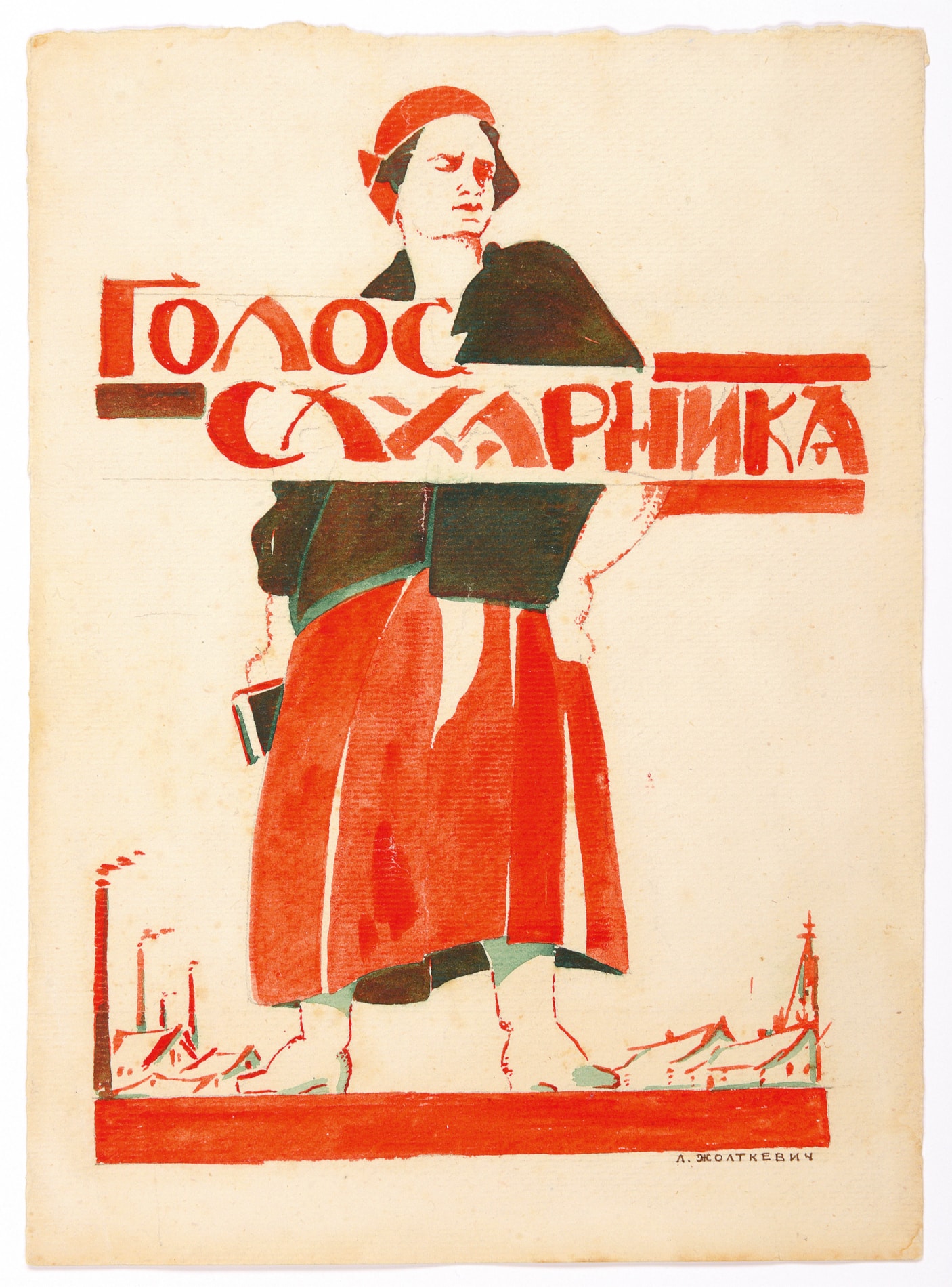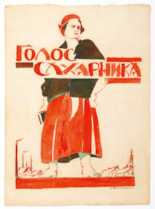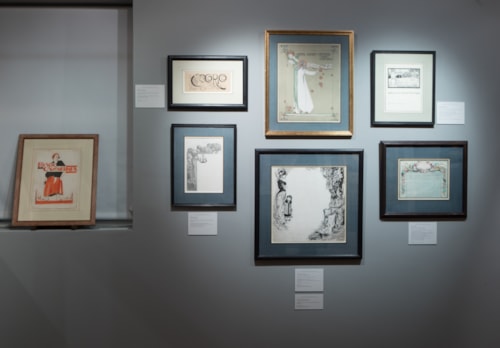Lidia Alexandrovna ZHOLTKEVICH
(Podlesty 1900 - Moscow 1989)
The Voice of the Sugar Factory Worker
Sold
Watercolour over a pencil underdrawing.
Inscribed ГОЛОС САХАРНИКА in red ink at the top.
Signed or inscribed А. ЖОЛТКЕВИЧ at the lower right.
280 x 203 mm. (11 x 8 in.)
Inscribed ГОЛОС САХАРНИКА in red ink at the top.
Signed or inscribed А. ЖОЛТКЕВИЧ at the lower right.
280 x 203 mm. (11 x 8 in.)
This drawing is likely to date from the 1930s, and may possibly be related to Lidia Zholtkevich’s work for the Russian pavilion at the 1937 Exposition Internationale des Arts et Techniques dans la Vie Moderne in Paris. The Soviet pavilion, awarded a gold medal by the organizers, commemorated the twentieth anniversary of the 1917 October Revolution. The front of the pavilion was dominated by a monumental, twenty-four metre high statue of The Worker and the Collective Farm Woman by Vera Mukhina, while the interior was made up of several halls featuring industrial models, social-realist murals, and a semi-precious stone mosaic map of Soviet industry, culminating in a mural by Alexander Deineka celebrating the legacy of the first two decades of Soviet power.
Adapting the visual language of the revolutionary movement of the 1920s, the present sheet - drawn with two bold colours of black and red, highlighted by a striking teal - depicts a female factory worker, with the prominent text translating as ‘Voice of the Sugar Factory Worker’. She is presented in a monumental stance, and wears the red headscarf of a supporter of Socialism. The image most likely refers to a telegram sent in September 1917 by the workers of the Georgievsky Company Sugar Factory in Petrograd (today Saint Petersburg) to the Russian Provisional Government in the city, condemning the possibility of a corrupt military dictatorship while underscoring the workers’ stance as worthy and principled Socialists. In the telegram, the workers of the Georgievsky Company Sugar Factory declared their full support of the Government: ‘we have utter confidence that only a unitary power in the person of the Provisional Government can save the homeland and the gains of the revolution, and that it will not allow a return to the past and thus assured we continue each in his own place to work calmly and with full energy for the good of the homeland.’
Adapting the visual language of the revolutionary movement of the 1920s, the present sheet - drawn with two bold colours of black and red, highlighted by a striking teal - depicts a female factory worker, with the prominent text translating as ‘Voice of the Sugar Factory Worker’. She is presented in a monumental stance, and wears the red headscarf of a supporter of Socialism. The image most likely refers to a telegram sent in September 1917 by the workers of the Georgievsky Company Sugar Factory in Petrograd (today Saint Petersburg) to the Russian Provisional Government in the city, condemning the possibility of a corrupt military dictatorship while underscoring the workers’ stance as worthy and principled Socialists. In the telegram, the workers of the Georgievsky Company Sugar Factory declared their full support of the Government: ‘we have utter confidence that only a unitary power in the person of the Provisional Government can save the homeland and the gains of the revolution, and that it will not allow a return to the past and thus assured we continue each in his own place to work calmly and with full energy for the good of the homeland.’
The Ukrainian-born artist Lidia Zholtkevich was the daughter of the Revolutionary sculptor Alexander Zholtkevich, who lived with his family in Paris between 1908 and 1917. The young Zholtkevich began her artistic training while living in Paris, first exhibiting her drawings in 1914 and the following year entering the private Académie Colarossi. On a par with the famed Académie Julian, the Colarossi school was known for accepting female students and allowing them to conduct life drawing from the posed male nude. In 1917 Zholtkevich returned to Russia with her family, and later enrolled at the Vkhutemas art and technical school in Moscow. With a curriculum similar to that of the Bauhaus, Vkhutemas (an acronym for Vysshiye Khudozhestvenno-Tekhnicheskiye Masterskiye, or ‘Higher Art and Technical Studios’) was established in Moscow in 1920 as, as one scholar has noted, ‘a specialized institution that would prepare qualified master artists, professors, and directors to work in both industry and higher education. It aimed to fulfill the state’s goals for efficiency and production by linking art with politics.’
Zholtkevich entered the Vkhutemas school shortly after Alexander Rodchenko had joined the faculty, which coincided with the period when he was moving away from abstract painting towards the Russian avant-garde movement to be known as Constructivism, characterised by bold colours, simple typefaces, and geometric shapes and compositions. The professors of Vkhutemas, mainly leftist artists, led the development of agitational art and propaganda, with the first works of the movement appearing soon after the Revolution of 1917. Other influential instructors during Zholtkevich’s time at Vkhutemas were the painter and designer Lyubov Popova and architect Alexander Vesnin. In 1925 Zholtkevich married the graphic artist, printmaker and illustrator Georgy Alexandrovich Echeistov, and she completed her studies in 1929, graduating with a speciality in woodcut prints. Shortly thereafter, between 1930 and 1931, she accompanied her former classmate, the Belarussian painter Meir Axelrod, on an excursion to Crimea as part of the first Five Year Plan, to create an artistic record of agricultural achievements in collectivisation. During her time at Vkhutemas, Zholtkevich had begun exhibiting with the Association of Graphic Artists at the House of Printing, and in the 1930s she received several official commissions. Her most substantial work for the government was producing designs for silk-screened panels on behalf of the People’s Commissariat for Food Industry for the Soviet pavilions at the International Exhibitions in Paris in 1937 and New York in 1939.
Zholtkevich entered the Vkhutemas school shortly after Alexander Rodchenko had joined the faculty, which coincided with the period when he was moving away from abstract painting towards the Russian avant-garde movement to be known as Constructivism, characterised by bold colours, simple typefaces, and geometric shapes and compositions. The professors of Vkhutemas, mainly leftist artists, led the development of agitational art and propaganda, with the first works of the movement appearing soon after the Revolution of 1917. Other influential instructors during Zholtkevich’s time at Vkhutemas were the painter and designer Lyubov Popova and architect Alexander Vesnin. In 1925 Zholtkevich married the graphic artist, printmaker and illustrator Georgy Alexandrovich Echeistov, and she completed her studies in 1929, graduating with a speciality in woodcut prints. Shortly thereafter, between 1930 and 1931, she accompanied her former classmate, the Belarussian painter Meir Axelrod, on an excursion to Crimea as part of the first Five Year Plan, to create an artistic record of agricultural achievements in collectivisation. During her time at Vkhutemas, Zholtkevich had begun exhibiting with the Association of Graphic Artists at the House of Printing, and in the 1930s she received several official commissions. Her most substantial work for the government was producing designs for silk-screened panels on behalf of the People’s Commissariat for Food Industry for the Soviet pavilions at the International Exhibitions in Paris in 1937 and New York in 1939.
Provenance
Private collection, Austria.
Literature
Emma Crichton-Miller, ‘Female artists take their turn in the spotlight’, Financial Times. FT Weekend: Collecting, 17 June 2023, illustrated p.3.





